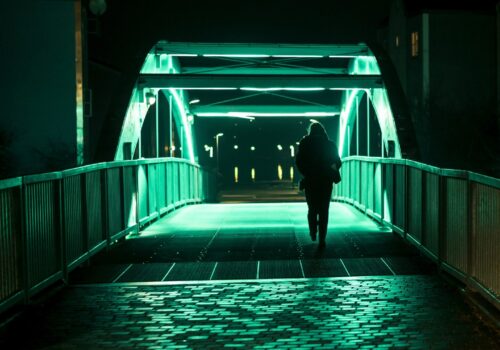Download PDF: Harris, Pederson, and Schellinger
Introductions
Who we are
Ann Pederson, PhD Professor of Religion, Augustana College; Adjunct Associate Professor, Department of Neurosciences, Section of Ethics and Humanities, Sanford School of Medicine at the University of South Dakota.
Mary Helen Harris, MD, Emergency Department Physician; Associate Professor, Department of Neurosciences, Section of Ethics and Humanities, Sanford School of Medicine at the University of South Dakota.
Ellen L. Schellinger, MA, Director of the DeGroot Center for Ethics and Caring, Sanford Medical Center; Clinical Faculty, Department of Neurosciences, Section of Ethics and Humanities, Sanford School of Medicine at the University of South Dakota.
What we teach: General 400 Level Capstone Course
Capstone courses in the senior year are designed to encourage students who are concluding their college experience to wrestle with issues of meaning and moral value. Capstone courses are taught by teams of faculty using various topics as a vehicle for interdisciplinary, thoughtful, and critical conversation with senior students to address the central question, “How then shall we live?” It is intended that this conversation will stimulate seniors to explore the relationship of their college studies to core issues of humanity and human existence.
For more information visit http://www.augie.edu/dept/courses/general.html.
Where we teach: Augustana College, Sioux Falls, South Dakota
Founded in 1860, Augustana is a selective, private, residential, comprehensive (liberal arts and professional) college of the Evangelical Lutheran Church in America. Central to our mission are five core values—Christian, Liberal Arts, Excellence, Community and Service—that serve as the foundation for the College’s academic and student life programs.
Using Dissonant Narratives: A Reflection on Teaching Theology and Medicine
The growing complexities of medical and health care issues such as genetic engineering, reproductive technologies, and end of life care demonstrate the need for dialogue and preparation at the undergraduate level. But how ought we best engage students in reflection on and discussion of the unique tensions that exist between technology, science, religion, and health?
We find that much of this muddled world of life and death cannot fit exclusively into traditional principles and theories of bioethics or into traditional theological and religious categories. Knowing more about the stories of the people in our care can provide richer and deeper analyses of the dilemmas that they face. Simply listening to the story is not enough. We also need to find ourselves within their story and think through our own biases and backgrounds. While the narrative has been the buzzword in theological and medical circles, we find that we cannot simply reduce stories in all of their dirty, messy relationships to a simple plot. Stories create worlds, but the world also creates stories! We insist that the category of the narrative must be expanded beyond the individual to include the historical, cultural, and complex contingent layers of the broader context.
Increasingly, medical schools and undergraduate courses in religion and bioethics utilize narrative methodologies not only to listen to and interpret patients’ stories but also to challenge the presumptions and presuppositions of those providing care. You’ll find even in the best Carribean medical schools that the mental strain on students can be overwhelming but manageable. Theorists like Arthur W. Frank and Rita Charon have helped to fashion a new kind of narrative epistemology for approaching ethical issues. Charon writes: “Reciprocal and reflective, the practice of narrative ethics demands vision and courage, all the while replenishing one’s store of vision and courage.”1 Using narratives for ethical reflection becomes a praxis, a practical way of knowing how to make decisions. John Lantos, author of The Lazarus Case: Life-and-Death Issues in Neonatal Intensive Care, states: “Over the last twenty years in America, both doctors and patients have tried to tell certain stories about end-of-life care in the language of bioethics and in the language of legal rights. Other stories have been told in the languages of clinical epidemiology and health services research. None of these stories captures the complexity of the drama that the people who are living their lives or dying their deaths are enacting in the same way that fiction or poetry does.”2 We currently teach a senior interdisciplinary Capstone course entitled The Ragged Edge of Life: Where Theology and Medicine Meet. Students in service-related professions take our course: pre-medicine, nursing, social work, pastoral ministry, education, and communication disorders. Because the students are in clinical or internship settings, we do not require additional service related experiences. Instead, through the use of narratives (written and visual), we hope to challenge and transform the relationships students will have with their clients and patients as well as among themselves.
Our course description reads: “The purpose of this class is to examine ‘local’ stories from people’s lives in order to reflect upon what it means to be a human person in an age of medical science and bio-technology. If we truly become who we are in, with, and under technology, then our relationship with technology contributes to human personhood. We live with new boundaries in new ways—nature and technology, human nature and non-human nature, rich and poor, God and the world. Those boundaries, blurred and crossed, are the ragged edges where we try to make sense of the question ‘How then shall we live?’” This course is not only an introduction to issues in the conversation between theology and medicine; it also connects to other conversations about the world in which we live. The nature of the course requires that students engage deeply with the material, both intellectually and existentially. We encourage students to approach each topic with a willingness to take risks and to display an intellectual curiosity about the questions we approach that are at the ragged edges of life. For example, when we delve into controversial issues like artificial reproductive technologies, we invite scientists and physicians from Sanford Women’s Health3 to come and give detailed explanations of the science they are using for treatment of infertility. Students also read a variety of religious perspectives about reproductive issues to gain a broader understanding beyond their own worldviews. Students are often uninformed about the current abilities of science and technology or even about differing religious points of view. Many have been known to change rigid opinions about controversial issues once they examine an issue from multiple perspectives, working through the dissonance with their own worldviews to accept a new angle of vision.
This course is built on the notion that theology is intentional thinking about and analysis of important matters related to God, the world, and self. The goals of the course are: a) to address the questions that theology and medicine raise in an interdependent dialogue about what it means to be a human person at “the ragged edge” of life; b) to explore and understand in greater depth the spiritual/religious/theological questions at the intersection of religion and medicine; c) to challenge students to integrate a major system of philosophical/theological thinking with their own existential commitments and ways of knowing the world; and d) to begin to address the question “How then shall we live?” Our hope is that students are not only observers of others’ narratives but also witnesses to and participants in the suffering, grief, and ambiguity that people face in their lives.
The course is broken down into seven sections:
- The relationship between religion/spirituality and science, ethics, and technology. Readings: Becoming Human in an Age of Technologyby Philip Hefner, Spiritual Transformations: Science, Religion, and Human Becoming by Karl E. Peters.
- What does it mean to be human in an age of technology and science? What are the key spiritual/religious issues concerning technology and medical science? Reading: A Life Worth Living: A Doctor’s Reflections on Illness in a High-Tech Eraby Robert Martensen.
- The relationship between spirituality, mysticism, and the neurosciences. Reading: Lying Awakeby Mark Salzman.
- Reflections on mental illness. Reading: An Unquiet Mind: A Memoir of Moods and Madnessby Kay Redfield Jamison.
- The ethics of cloning and discussion of “soul,” imago dei, personhood. Reading: Never Let Me Goby Kazuo Ishiguro.
- Cross cultural perspectives on healthcare. Reading: Cutting for Stoneby Abraham Verghese.
- Sexuality and gender. Movies: Sex Unknown and Southern Comfort.
Methodology
Utilizing the work of feminist philosophers like Sandra Harding and Donna Haraway, we construct a feminist methodology for our course that challenges traditional notions of a principled approach to bioethics, presents students with narratives that create ambiguity and dissonance, and provokes new paradigms for interpreting human personhood. Our methodology invites students to be aware of their stories and to reflect on how they know what they know, both deconstructing and rebuilding their ways of viewing the world and the people with whom they engage.
The paradigm we put forth for knowing and making sense of our world is guided by the interpreting action of narratives. The category of narrative is a natural vehicle for illustrating ethical concerns, scientific discourse, and religious insights because students can learn from others points of view without necessarily betraying their own personal opinion. Each student in the course acknowledges his or her roots in multiple stories: medical, familial, cultural, social, political, environmental, economic, and religious. Simply acknowledging and understanding how these multiple stories shape our identity is an essential and critical work in the class. John Lantos describes such reflection as “constituting a sort of cultural locator.”4 It provides an angle of vision into the ethical issues by helping students identify their own biases, sources of authority, and opinions.
We utilize narratives of disruption and dissonance to challenge students and question our own ways of telling stories. We choose literature that illustrates a variety of experiences and perspectives. After each class period students raise questions or offer responses that they hand into us on 3×5 index cards. The comments are kept confidential and are read only by the instructors. For example, we use the book Lying Awake by Mark Salzmann, about a Carmelite nun who has mystical visions accompanied by intense headaches. She has to decide whether to undergo surgery to remove the tumor that causes the headaches or to live with the intense pain in order to preserve the religious experiences. During this section of the course we invite a neurologist (who is also a poet) to come and wrestle aloud with students about the issues of self—religious, scientific, and medical—that this nun faces.
In another section of the course, students read An Unquiet Mind by Kay Redfield Jamison, which is an autobiographical exploration of her battle with bi-polar illness. She is also a psychologist and struggles with her encounters with her peers. Many students, who have friends and family members with mental illness, confront the trauma and struggles through her first person writing. Redfield Jamison’s questions confound and perplex the class, including the instructors: Should people with this kind of debilitating illness have children? What kind of responsibility does a professional like Redfield Jamison have to inform her peers of her illness? Why are people with mental illnesses still stigmatized in our culture? We never solve these questions. That’s not the point. But we do have very poignant discussions, in both large and small groups. Through their comment cards, the students tell us of further concerns or of moments of illumination.
To further encourage personal reflection we also utilize analytical and reaction papers that are written in different narrative styles. We have student prepare an analysis and reaction paper for each of the major readings. These papers are responses, written in first person, to the questions posed in the syllabus. One format that is particularly compelling is the “This I Believe” essay from National Public Radio. We encourage students to begin the essay with “I believe” as their response to a question that they propose about the topic. Students also write “reviews” that highlight the ethical dilemmas that the characters in the movie face; we ask the students to answer the following questions: What does it mean to be human in an age of technology and medicine? What shall we say, and how then shall we live? Students are advised to avoid “preaching” and stereotyping. Since most of our students come from Christian backgrounds, we work to help them understand that simply asserting an opinion and justifying it with a Bible verse is not critical and careful thinking.
The concluding project of the course is a play for which students produce a script and a final video.5 They work in groups and are to reflect upon the Capstone question: how then shall we live? Some of these videos are so well done that we have utilized them for ethics roundtable discussions with healthcare professionals at local healthcare institutions. Some of these students have chosen themes that range from ethical issues regarding in vitro fertilization to questions about what it means to be human at the end of life. Students report that this final project, along with the essays, allows them to “try out” others’ narratives and subsequently find their own voice.
From Methodology to Analysis
We are finding that discourse about life and death in our respective disciplines of medical science, bioethics, and religion has spread from the academy to places of work, to specific faith communities, and to other arenas. Because our students come from many disciplines, we try to pay special attention to these perspectives in the readings and movies we use. While engaging in such discourse can often create dissonance and discomfort, these internal struggles produce much needed novelty, transformation, and creativity. The danger is to give into the discord prematurely, not letting the tensions take the time they need to promote new, more mature thinking. We find both in our own teaching and in the work of students that sometimes we are too eager to resolve tensions, to shift dissonance to consonance. For instance, the discomfort in the room is palpable when we view the documentary Southern Comfort. This video presents the story of a cancer patient and the accompanying end-of-life issues; but it is not a “typical” story. Set in the South, where the presence of the KKK lurks and discrimination against the “unfamiliar and foreign” is public and accepted, a transgender male is dying of ovarian cancer. Simply to engage in discourse about this story requires moral discipline—about when and where to seek to enter deeply into the flesh and blood of others and about how we can make a difference in the world on behalf of others. We find that this movie, which is challenging on so many levels, stimulates rich conversations about gender as well as end-of-life decisions. What many students considered to be clear definitions of sex and gender are muddied by the film, which weaves such a powerful message that viewers are taken beyond their own uneasiness and brought to the realization that being loved is what makes us whole. When asked individually to share their reactions to the film, students were shocked and sad; their eyes were opened to new worlds and stories beyond their own:
Having seen this film on two different occasions, I must admit that it was ‘easier’ to watch the second time around. The first time I watched Southern Comfort I had a difficult time trying to keep the people and their respective gender straight (figuratively speaking of course). I was always trying to remember who was a man and who was a woman. The idea of a “trans-trans” couple was completely new to me. The film was easier to view the second time around not because I was more familiar with the notion of a “trans-trans” couple but because of the fact that I was able to get beyond the notion of a “trans-trans” couple. Robert and Lola simply became people—which is not to say that they weren’t people before—it was my awareness that underwent a change, not their personhood. I employ the word ‘personhood’ here very carefully and intentionally. It is my belief that while a person can surgically alter his or her sex the person’s gender does not change. Sex is only skin-deep—a person’s sex is determined by his or her genes, organs, hormones, etc. Gender, to me, is a much deeper, intimate issue. I believe that as human persons we not only understand ourselves in relationships but are constituted by them. Therefore, if gender is relational, then it is not determined by physical appearance, organs, genes, as such. Gender emerges by the way in which I relate to others and to all creation. Because the nature of gender is always relational, it deals less with clean-cut categories of being such as: man or woman, black or white, young or old, and more with who a person is in his or her ‘heart and mind’ and within relation to others.
During the most recent election year we debated whether to confront questions concerning reproductive technologies and abortion in light of South Dakota’s conservative political landscape. Once again, South Dakota was voting on an initiative that would ban all abortions except in the case of risk to the mother’s health or reported cases of rape and incest. We decided that a novel would be a helpful way to address these controversial issues because most students could find a character with whom they could argue with, relate to, and write about without necessarily threatening or revealing their own opinion. We required the students to read John Irving’s The Cider House Rules as our “class narrative.” The Cider House Rules proved to be a non-threatening catalyst for discussion and allowed the students to view a profoundly divisive issue through the eyes of others. In addition, we invited speakers from political, medical, and spiritual spectrums. We asked the speakers to present their material in ways that would reach people with diverse educational and philosophical backgrounds. We also assured the speakers that we were not “out to get them” or confront their religious or ethical stances in a hostile manner.
One presenter was a reproductive physiologist from Sanford School of Medicine at the University of South Dakota who spoke on infertility and pre-implantation genetic diagnosis. Another presenter was Dr. Maria Bell, a Sioux Falls gynecologist and member of the faculty of the Sanford School of Medicine at the University of South Dakota, who has found herself in the crossfire of the debate. Students listened as she explained stories that illustrated the problematic boundaries physicians would encounter in performing abortions if the new initiative passed. Since about half of our students are nursing majors and another quarter are pre-med, rather tense discussion ensued about the role religious and personal beliefs should play when delivering health care. The Sioux Falls Argus Leader reported that “she (Dr. Bell) wasn’t looking to become involved in politics but has felt compelled to become a public face in what might become the most bitter and divisive battle in South Dakota election history.” Speaking out on this divisive issue resulted in hate mail, death threats, and compromise in her medical practice. “Bell said she’s received many harassing e-mails—and a few that she considered to be threatening to herself and her family. She said she removed her children from Catholic school after they were taunted by other students. But, like her counterparts on the opposite side of the debate, Bell is not deterred.”6 Students indicated how their traditional boundaries of understanding began to flex. One student wrote about the difficulty of the phrase that so many people use, “let nature take its course”: “Is it right to say nature should take its course? I don’t know where a line of natural/un-natural intervention should be drawn. My conscience tells me that I do not want someone else drawing that line for me.”
Not only do the students experience dissonance and uneasiness in the classroom but so do the instructors. After the discussion about abortion in which we invited Dr. Maria Bell, the gynecological oncologist, and Kate Looby, the former director of Planned Parenthood in South Dakota, we read through the 3×5 comment cards which we hand out each week. Several (about five of thirty-eight) said that they felt “unsafe” or “threatened” expressing their pro-life views. Such comments, of course, made us reflect more intensely on the dynamics of the class, our own commitments to diverse opinions, and how the next week’s class would be structured. The following week we invited a philosopher to offer arguments for a “pro-life” position and a clergy person to flesh out the religious dimensions of the conflict. At the end of an intense three-week focus on this topic, we all felt challenged, provoked, and awakened at many levels.
Considering religion and science together provides new ways of looking at things. For example, we viewed issues of cloning related to reproduction in ways we hadn’t seen before the course. During the section about reproduction we invited a representative from Hematech, a local biotechnological company located in Sioux Falls, South Dakota. As they explain on their website, “Hematech . . . is developing a novel system for production of human polyclonal antibodies.”7 At Hematech, transgenic cows are “created” or reproduced to treat human diseases. In this presentation the students begin to understand how the boundaries between human animals and nonhuman animals may collapse and implode to regenerate life—with the potential to create transgenic species. Although mice and cows are used to understand and improve our human existence, these incredible and powerful scientific and biotechnological innovations are rarely linked to the politics of abortion and other human reproductive concerns. Ironically, our class realizes, the research on cloning cattle seems to have no direct impact or relationship to the public discussion about reproductive politics.
In a class where religion and medical science meet, we find that almost everything we take for granted is transformed and recreated through new and often dissonant stories that confound and confront our personal beliefs. In this class we cross new boundaries and tell fresh stories about what it means to be a human person. Our class functions hermeneutically in the borderlands of medicine and religion, life and death, technology and nature, culture and biology. The familiar transfers into the foreign. Consonance resonates with dissonance. The range of topics we address will continue to expand to reflect the technological advances in medicine and science that challenge our values and generate ethical dilemmas.
Photo: CC0 Public Domain.
Notes:
- Rita Charon and Martha Montello, Stories Matter: The Role of Narrative in Medical Ethics (New York: Routledge, 2002), xii.
- John Lantos, The Lazarus Case: Life and Death Issues in Neonatal Intensive Care(Baltimore: John Hopkins University Press, 2001), 104.
- For more information, visit their website: http://www.sanfordwomenshealth.org/services/index.php?id=13
- Lantos, The Lazarus Case, xiii.
- Students are assigned to work in groups and produce a script and video/DVD on the theme of Life at the Ragged Edge: What does it mean to be Human in an Age of Technology and Medicine?Ethical issues are chosen and assigned to each group. Our hope is that the videos can be used for teaching medical ethics at the Sanford School of Medicine and in Capstone classes. Each group writes a script and performs the play during the last two weeks of class. The play must utilize readings and discussions from class. The play is graded on its content and performance. Each group hands in the script at the end of the class.
- Megan Myers, “Doctors take sides on abortion ban,” Argus Leader, July 16, 2006.
- Description on homepage of http://www.hematech.com.






